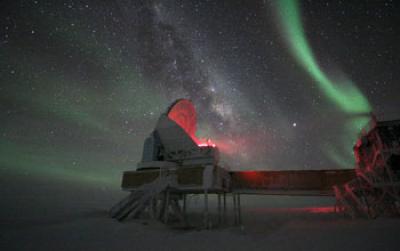An extraordinary galaxy cluster was discovered by the South Pole Telescope (SPT) located at Amundsen-Scott South Pole Station in Antarctica. This telescope was funded by the National Science Foundation. The cluster, which was officially known as SPT-CLJ2344-4243, is called the Phoenix cluster since it is found in the Phoenix constellation.
 A galaxy cluster was discovered by this 10-meter wide South Pole Telescope, which is located at NSF's Amundsen-Scott South Pole Station in Antarctica and funded by NSF's Office of Polar Programs. NSF manages the US Antarctic Program, through which it coordinates all US research and required logistical support on the continent as well as aboard ships in the Southern Ocean. Credit: Keith Vanderlinde, National Science Foundation
A galaxy cluster was discovered by this 10-meter wide South Pole Telescope, which is located at NSF's Amundsen-Scott South Pole Station in Antarctica and funded by NSF's Office of Polar Programs. NSF manages the US Antarctic Program, through which it coordinates all US research and required logistical support on the continent as well as aboard ships in the Southern Ocean. Credit: Keith Vanderlinde, National Science Foundation
This cluster was found to be using the Sunyaev-Zel'dovich (SZ) effect, giving high energy electrons that distort the cosmic microwave background (CMB) radiation via inverse Compton dispersion. This imparts an average energy boost to the low energy CMB photons at the time of impact with the high energy cluster electrons.
Michael McDonald, the lead author of a paper published in the August 16 issue of the journal Nature and a Hubble Fellow at the Massachusetts Institute of Technology, stated that galaxies located at the middle of most clusters have been lifeless for billions of years; however central galaxy in this cluster appears to have regained life, like the mythological Phoenix, a bird which is said to rise from the dead.
Studies made by NASA's Chandra X-ray Observatory in space, the Gemini Observatory managed by NSF, and the Blanco 4-meter and Magellan telescopes in Chile confirm the SPT discovery and demonstrate that stars are forming at a very high rate in the middle of the cluster.
The SZ effect, which was predicted in 1972, was initially demonstrated to trace unidentified clusters of galaxies by the SPT collaboration in 2009. When light passes through a large cluster on its way, a tiny fraction of the light gets dispersed to higher energies. This results in SZ effect.
John Carlstrom, SPT's principal investigator and the S. Chandrasekhar Distinguished Service Professor in Astronomy & Astrophysics at the University of Chicago, stated that the beauty of the SZ effect makes it easy to detect a cluster of galaxies which are far away and the degree of the effect does not depend on its distance from Earth, but rather depends on the mass of the object.
Phoenix is found to contain a vast reservoir of hot gas like other galaxy clusters, but comprising more amounts of normal matter than all the galaxies in the cluster combined. X-ray telescopes like NASA's Chandra X-ray Observatory was used to detect this emission.
Co-author Bradford Benson from the University of Chicago stated that the galaxy and its black hole are going through an unsustainable growth and this growth will not last more than hundred million years since the galaxy and the black hole may turn larger than other galaxies in the nearby universe.